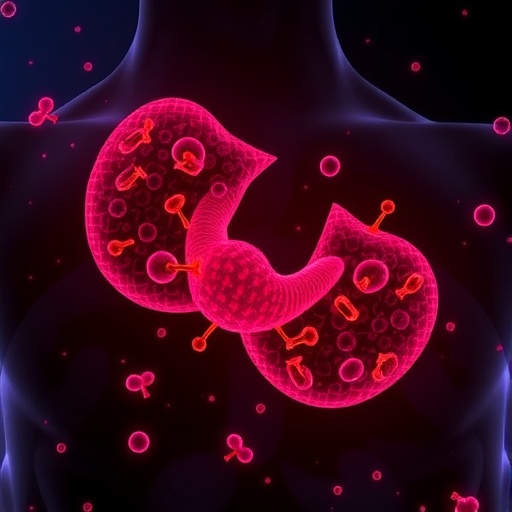
In a groundbreaking study poised to reshape our understanding of gastric cancer biology, researchers have uncovered a novel molecular mechanism by which the transcription factor FOXP2 exerts profound tumor-suppressive effects. Gastric cancer remains one of the leading causes of cancer-related mortality worldwide, and despite advances in treatment modalities, the intricate molecular pathways driving its progression have remained partially elusive. This latest discovery not only highlights the pivotal role of FOXP2 but also elucidates an unprecedented regulatory axis involving the repression of FBXW2 and the consequential degradation of WASL, offering promising new avenues for therapeutic intervention.
The research delineates how FOXP2, a member of the forkhead box family of transcription factors traditionally studied in neural development, functions as a repressor in gastric cancer cells. Intriguingly, FOXP2 exerts its tumor-suppressive influence by downregulating FBXW2, an F-box protein implicated in various cellular processes, including protein ubiquitination and degradation pathways. This transcriptional repression initiates a cascade that ultimately culminates in the depletion of WASL, a key modulator of actin cytoskeleton dynamics, which is crucial for cancer cell motility and invasion.
One of the most compelling insights from the study is the identification of FOXP2’s direct binding to specific promoter regions of the FBXW2 gene, thereby attenuating its transcriptional activity. Through a series of chromatin immunoprecipitation assays combined with luciferase reporter analyses, the authors demonstrated that FOXP2 physically associates with FBXW2’s regulatory sequence, functioning as a transcriptional brake that stymies FBXW2 expression. This molecular interaction serves as a critical control node that suppresses the downstream signaling cascade facilitating tumor progression.
.adsslot_CqmSkJw7aG{width:728px !important;height:90px !important;}
@media(max-width:1199px){ .adsslot_CqmSkJw7aG{width:468px !important;height:60px !important;}
}
@media(max-width:767px){ .adsslot_CqmSkJw7aG{width:320px !important;height:50px !important;}
}
ADVERTISEMENT
The degradation of WASL, an actin nucleation-promoting factor, emerges as a crucial effector mechanism within this axis. Under normal circumstances, WASL promotes cancer cell invasion by facilitating cytoskeletal remodeling and lamellipodia formation, essential for cell migration. However, the FOXP2-mediated suppression of FBXW2 leads to an increase in ubiquitin-dependent degradation of WASL, effectively disarming the cell’s invasive machinery. This finely tuned proteolytic regulation underscores the sophisticated interplay between transcriptional repression and cytoskeletal dynamics that governs cancer cell behavior.
Further mechanistic exploration revealed that the FOXP2-FBXW2-WASL axis profoundly affects multiple cellular phenotypes associated with malignancy. FOXP2 overexpression led to markedly diminished gastric cancer cell proliferation, migration, and invasion in vitro, accompanied by increased apoptotic rates. Conversely, silencing FOXP2 reciprocally elevated FBXW2 levels and stabilized WASL expression, augmenting the aggressive cancer phenotype. These reciprocal effects emphasize the functional indispensability of this regulatory pathway in maintaining cellular homeostasis and restraining oncogenic transformation.
This discovery also provides a vital context for understanding the heterogeneity observed in gastric tumors. Clinical sample analyses showed an inverse correlation between FOXP2 and FBXW2 expression levels, substantiating the relevance of this molecular interaction in human disease. More aggressive gastric tumors exhibited significantly reduced FOXP2 levels alongside elevated FBXW2 and WASL expression, linking these molecular markers with poor patient prognosis. Thus, FOXP2 status might serve as both a prognostic biomarker and a potential therapeutic target in clinical settings.
The integration of FOXP2 within the ubiquitin-proteasome system via FBXW2 modulation opens an exciting new chapter in targeted cancer therapeutics. FBXW2, as an E3 ubiquitin ligase component, orchestrates substrate specificity for protein degradation pathways, and its regulation by FOXP2 introduces a novel transcriptional control layer over proteostasis in cancer cells. These findings reveal how transcription factors can indirectly govern proteasomal degradation by modulating the availability of pivotal ubiquitin ligase components, thereby influencing oncoprotein stability and cellular invasive capability.
Moreover, the study’s comprehensive methodological approach incorporated gene editing techniques such as CRISPR-Cas9 mediated knockout models, alongside RNA interference and overexpression systems, to validate the causative roles of FOXP2, FBXW2, and WASL in vitro and in vivo. Xenograft models in immunocompromised mice demonstrated that FOXP2 restoration significantly curbed tumor growth and metastatic dissemination, further corroborating the tumor suppressor function of FOXP2. These in vivo results reinforce the translational potential of this axis for developing novel therapeutic interventions.
In addition to its profound biological implications, the FOXP2-FBXW2-WASL pathway underscores the intricate relationship between transcriptional regulation and cytoskeletal remodeling, two central pillars of cancer cell biology. The actin cytoskeleton’s dynamic restructuring is essential for key tumorigenic processes, including epithelial-mesenchymal transition (EMT), which facilitates metastatic dissemination. By promoting WASL degradation, FOXP2 effectively dampens EMT-associated traits, thereby limiting the cancer cells’ metastatic capability.
The identification of FOXP2’s repressive role also challenges prior assumptions that primarily ascribed this transcription factor to neurodevelopmental contexts, expanding its functional repertoire into cancer biology. This revelation opens transformative perspectives for researchers investigating forkhead box family proteins, urging a reevaluation of their context-dependent roles across diverse tissue types and pathological states. FOXP2’s dual utility, as both a transcriptional regulator in normal physiology and a suppressor in oncogenesis, exemplifies the multifaceted nature of gene regulatory networks.
On the therapeutic front, the modulation of FOXP2 activity or mimicking its suppressive effects on FBXW2 offers a tantalizing strategy to restrain gastric cancer progression. Small molecules or biologics engineered to enhance FOXP2 expression or function may restore the downregulated tumor-suppressive axis, thereby impeding cancer cell proliferation and invasiveness. Additionally, targeting the FBXW2 ubiquitination machinery to promote WASL degradation could synergize with existing chemotherapies, potentially improving clinical outcomes.
This study also sparks curiosity about the broader applicability of the FOXP2-FBXW2-WASL axis beyond gastric cancer, prompting investigations into other malignancies where similar pathways might be operative. Given the conserved roles of ubiquitination and actin dynamics in various cancers, analogous regulatory mechanisms could be at play, paving the way for generalized cancer therapeutic innovations. Future research directions may include high-throughput screening of FOXP2 modulators or examining patient stratification based on FOXP2-FBXW2 axis expression profiles for personalized medicine approaches.
In conclusion, the elucidation of FOXP2’s transcriptional repression of FBXW2 and its downstream effect on WASL degradation represents a significant leap forward in the molecular oncology landscape. This research not only deepens our grasp of gastric cancer pathogenesis but also unlocks new molecular targets ripe for drug development. As the global burden of gastric cancer continues to challenge health systems, innovative insights such as these are vital for transforming patient prognoses and curbing cancer’s deadly toll.
The authors of this study have elegantly revealed how transcriptional regulation interfaces with proteostasis and cytoskeletal architecture to hinder cancer progression. Their findings underscore the importance of multifaceted molecular approaches to decode complex disease mechanisms. This landmark research will undoubtedly catalyze further studies and inspire novel therapeutic strategies anchored in the FOXP2-FBXW2-WASL regulatory network.
Subject of Research: The molecular mechanisms by which FOXP2 suppresses gastric cancer progression, focusing on transcriptional repression of FBXW2 and subsequent degradation of WASL.
Article Title: FOXP2 suppresses gastric cancer progression by transcriptionally repressing FBXW2 via WASL degradation.
Article References:
Lin, S., Kong, W., Liu, X. et al. FOXP2 suppresses gastric cancer progression by transcriptionally repressing FBXW2 via WASL degradation. Cell Death Discov. 11, 348 (2025). https://doi.org/10.1038/s41420-025-02643-1
Image Credits: AI Generated
DOI: https://doi.org/10.1038/s41420-025-02643-1
Tags: actin cytoskeleton dynamicscancer cell motilitycancer-related mortality factorsF-box proteins in cancerFBXW2 repressionFOXP2 transcription factorgastric cancer biologymolecular pathways in cancertherapeutic interventions for gastric cancertranscriptional regulation in oncologytumor-suppressive mechanismsWASL degradation






